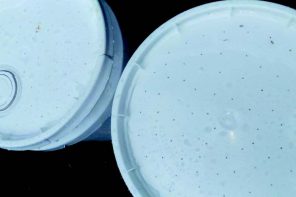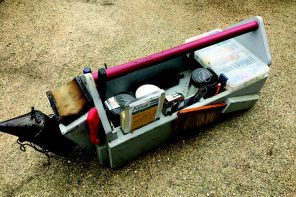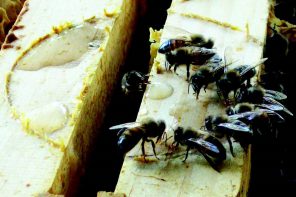By: Kim Flottum
“America’s farmland is disappearing at a rate of three acres every minute.” American Farmland Trust.
AFT surveys land use with more precision than anybody or any agency I am aware of. I’ve been following their land use studies since they started making them, in conjunction with the Federal Government, 20 some years ago. And that’s ‘farmland’ they are measuring. The places we grow food, fiber, forest, pasture and more food.
Let me put that in perspective. This year we planted some 80 million acres of soybeans. Losing three acres of soybeans every minute, in 50 years all those acres will be gone – converted to concrete parking lots, freeways, lawns, factories, parks and flooded land from rising seas. Or share the pain and figure half the corn and half the soybeans will be gone. Better, at that rate in only 33 years ALL of the National Parks will be gone. One more, in only a single year losing three acres a minute, all the almonds in California would be gone. All of them.
Yet another. This year there’s right about 23 million acres of CRP land. That’s where beekeepers go to stay away from pesticides, to get enough safe food for their bees, because corn and soybeans and almonds aren’t safe. At three acres a minute, in 14 years, all of the CRP land is gone. And, I’d bet, so are all the beekeepers who used to use that land for summer refuge from the harder side of life.
Speaking of which, only about 17% of the land in the continental U.S. is agricultural. With right about 1.9 billion total acres in the U.S. then, that means there’s roughly 325 million or so acres of good cropland to start with. Let’s see. Losing three acres a minute, it should take just over 200 years to eat that all up with – stuff that isn’t farm land.
As an aside, there’s right about four million acres of paved roads in the U.S., but 40 million acres of tidy lawns beautifully mowed, fertilized, chemically weeded, and enjoyed by all the corporate land owners at Headquarters USA, and of course neighbors and their homeowner associations, cities and urban parkland, golf courses and athletic fields everywhere.
But wait, there’s more. Between 1992 and 2012, we converted 31 million acres of ag land, including woodlands and low-density residential development, into non-agricultural land. That’s most of Iowa, or the entire state of New York. Of that, more than 70 percent of urban development and 62 percent of all development took place on ag land. Urban expansion was 59% of all of that including commercial, industrial, transportation and high-density residential development. And low-density development, that is exurban homes on large lots, took 41 percent of that.
Obviously all farmland isn’t used for intense row crop production. It includes pasture, forest, and rangeland, which, in some cases renders it less developed than cotton or citrus acres. And by less developed I essentially mean safer-to-be-on land, rather than tread-upon-at-your-own-risk land.
And, as the best land is gobbled up, land that is more marginal gets used, so even the average to almost useless land is now farmland that once was, for all intents, safe forage land. It just gets worse and worse.
And let’s take a look at that really good land, where it is and what’s happening. Look at a U.S. continental map.
Cropland is, for the most part most of SD, the eastern half of ND, southern half of MN and WI, most all of IA, IL, IN, east OH, the north half of MO and some of NB and KS. Then follow the Mississippi river to the gulf, and add in a bit of east TX and south FL. Add in range land from NV to CO mostly north to south and throw in the big valley in CA and a tad in northern WA and that’s about it. Lots of forest in the east third of the country, but lots of urban there also.
How much is used, however, is a bit different. The best is used for sure, but marginal land is more and more put to the plow to make up for the losses of the good land. Figure from MT, then ND all the way south to TX and all the way west to OH, and down the Mississippi river as basic agriculture, and some of the remaining western states as federal grazing land. And all of this, good and bad, is disappearing at three acres a minute.
And water. The changing climate has caused shifts in where things can be grown, even if there isn’t competition for urban development or other uses. These changes include rising temperatures, increase in frost-free periods, increases or decreases in extreme weather events like droughts, floods, fires and heat. Add to this decreased winter-chill units making it impossible to grow some fruits now, along with hurricanes and increased precipitation leading to less fertile and increasingly eroded landscapes.
Oh, I almost forgot energy production. It’s predicted that in the next 20 years, domestic production from all energy sources will rise by nearly 30 percent and impact about 200 million additional acres – that’s bigger than Texas, just so you know. These include nuclear, natural gas, coal, renewables like wind, geothermal, solar and hydropower and biomass, and biofuels like corn, sugarcane, soy and cellulose.
Then there’s ownership. Something like 40 percent of all U.S. agricultural land is owned by people over the age of 65 (sound familiar?), and over the next 20 years something like 350 million acres could change hands, and beginning farmers have issues with debt, startup costs and affordable land. Average farmland in the ag belt ranges from something like $7000 – $12,000 an acre. But convert that land to urban development, and it goes for something like $30,000 an acre in some urban locations, down to as low as $20,00 in less developed areas. You can guess who to sell Dad’s farm to.
As a result of all this there are fewer, and fewer and fewer places to let your bees roam that are productive, safe and easy to get to.
Those three acres of farmland that are disappearing every minute are turning into those roads, parking lots, lawns, factories, city parks, solar and wind energy generators, gas pipelines, biomass producing land, and land covered with water that wasn’t covered with water just a couple of years ago. People and climate change are eating your bees’ forage at three acres a minute, every minute of every day, all year long. Three acres. Every minute.
Why all this? Well, I just listened to a well-meaning, terribly ill-informed, environmental activist screaming at beekeepers about how they are killing their bees by – one, stealing all their honey every Fall; two, feeding them HFCS to make up for that; three, cramming them in boxes they are not meant to live in; four, poisoning their home environment with chemicals used to kill mites instead of letting the bees not resistant die and keeping only those that survived; five, putting them on trucks and subjecting them to truck fumes, disruption of their seasonal cycles, and denying them their normal and healthy food sources, and six; stacking them 10 deep by the acre in holding yards and making them share all of the problems bees have from everywhere they came from; all this so they can go someplace somewhere to pollinate some crop for money for the greedy beekeeper.
I know you’ve heard that person a lot of times saying basically the same thing about greedy beekeepers taking advantage of their bees simply for profit. We are an easy target for some groups who what to blame the ills of the world on someone else. Ignoring them is usually the best way to handle that, or at least I thought it was for a time anyway. But they lump in all manner of cruel and unusual crimes here, implying that our actions are actually killing the bees that put food on our tables.
So for what it’s worth, here’s what I think.
Because that person buys three quarters of his honey from some beekeeper in another country, and because that person chooses to live in that new suburban development just north of town that was a farm two years ago, that now has a lush, bee-free lawn pampered with water diverted from a nearby irrigation water source, and because that person wants a pristine, hosed down once a week to get the dirt and stuff off so that it can go into the local waste water disposal parking lot when he goes to a distant, low-priced corporate-owned store on a newly constructed road in his gasoline driven car, and carries home his groceries in a plastic bag that goes to a new land fill on the other side of town so the smell doesn’t interfere with his backyard picnic near the pool filled with water that could have helped that farmer just out of town water his cattle or his crops, but now he can’t so he sold out to that developer and made a fortune to retire on, and sometimes shops at a local farm market, but usually buys produce and meat and dairy and everything else that’s fresh and in season from that grocery store he got his honey from and that comes from a farmer south of the border at way, way less than the local CSA can sell it for . . .
OK, take a breath, Kim.
So, you see where this is going. When people talk about bees dying you should talk about people being greedy, unthinking and uncaring. It’s not beekeepers that are killing bees, it’s the people beekeepers are trying to feed that are killing bees. It’s a simple fact. They are their own worst enemies. It ain’t that bees are dying. It’s that our caring consumers are killing them, at three acres a minute.
And this brings me to our latest information news source. As you probably know, every day we send out a news piece from somewhere dealing with the business of bees in some form or other. It’s our daily CATCH THE BUZZ. This little item reaches, either directly or passed on from newsletter and Journal Editors, or other social media folks, nearly 43,000 people a day. Yes, 43,000 a day. Now, if you are like me and a news junkie, you’ll read at least five of those a week and usually all of them (there are usually six). If you’re not, we’ve found, you’ll pick up on three or four, but, and this is important, later, you’ll go to our web page and scan those you missed. The BUZZ is a lot of work, but it reaches a lot of people with what we think is both useful and interesting information.
So, we are going to try something a little different. If you read the information above on land use changes and the reasons whey, you should have noticed that some of the three acres of land a minute we are losing is due to the effects of climate change – this is, our weather is causing droughts, floods, rising coast lines, warmer and shorter Winters, longer and hotter Summers – and all of these things, one way or another, are affecting our bees, where our bees can forage, and what’s available when they get there. And knowing what to expect is half the battle. So, starting in early August, we introduced CLIMATE CHANGE CACHETS. Four or five short pieces once a week that are pretty much directly affecting what we as beekeepers do, can do, should do or shouldn’t do because of all this.
So watch for CLIMATE CHANGE CACHETS once a week, usually on the weekend, edited by our regular correspondent Alan Harman.
Bee Prepared.










